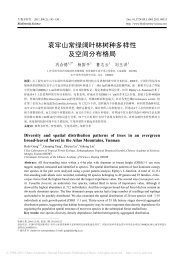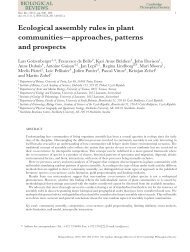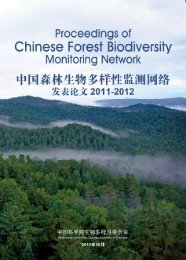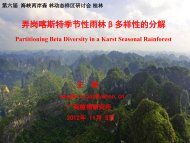the maintenance of species-richness in plant communities
the maintenance of species-richness in plant communities
the maintenance of species-richness in plant communities
Create successful ePaper yourself
Turn your PDF publications into a flip-book with our unique Google optimized e-Paper software.
Ma<strong>in</strong>tenance <strong>of</strong> <strong>species</strong>-<strong>richness</strong> <strong>in</strong> <strong>plant</strong> <strong>communities</strong> 127<br />
<strong>in</strong> temperate grassland may succeed <strong>in</strong> regenerat<strong>in</strong>g an adult <strong>in</strong> a certa<strong>in</strong> gap if <strong>the</strong>re<br />
is no heavy frost-heav<strong>in</strong>g (and subsequent drought risk) and plenty <strong>of</strong> ra<strong>in</strong> <strong>in</strong> w<strong>in</strong>ter,<br />
but if <strong>the</strong>re is plenty <strong>of</strong> frost-heav<strong>in</strong>g and/or no ra<strong>in</strong>, <strong>the</strong>n a spr<strong>in</strong>g germ<strong>in</strong>at<strong>in</strong>g<br />
<strong>species</strong> is at an advantage. An example was observed by Salisbury (1929, p. 222);<br />
all <strong>the</strong> seedl<strong>in</strong>gs <strong>of</strong> <strong>the</strong> autumn-germ<strong>in</strong>at<strong>in</strong>g Ranumulus parviJeonCs were destroyed<br />
dur<strong>in</strong>g severe and prolonged w<strong>in</strong>ter frosts whereas seedl<strong>in</strong>gs <strong>of</strong> ‘ Helian<strong>the</strong>mum brewmi’<br />
(Tuberaria guttata (L.) Fourr.) germ<strong>in</strong>at<strong>in</strong>g <strong>in</strong> spr<strong>in</strong>g escaped <strong>the</strong> hazard. In fact <strong>the</strong><br />
year can be partitioned by <strong>the</strong> germ<strong>in</strong>ation periods <strong>of</strong> different <strong>species</strong> <strong>in</strong>to shorter<br />
spells than autumn or spr<strong>in</strong>g, as shown for weed <strong>species</strong> <strong>in</strong> Central Europe <strong>in</strong> Fig. 9.<br />
Some <strong>species</strong> spread <strong>the</strong> risk, germ<strong>in</strong>at<strong>in</strong>g <strong>in</strong> autumn and spr<strong>in</strong>g or discont<strong>in</strong>uously<br />
throughout <strong>the</strong> year. Certa<strong>in</strong> <strong>species</strong> with this ‘strategy’ show an obvious seed<br />
dimorphism related to <strong>the</strong> <strong>ma<strong>in</strong>tenance</strong> <strong>of</strong> at least two germ<strong>in</strong>ation periods (Harper<br />
et al. 1970).<br />
Much is known about <strong>the</strong> physiological control <strong>of</strong> <strong>the</strong> tim<strong>in</strong>g <strong>of</strong> germ<strong>in</strong>ation <strong>in</strong> <strong>the</strong><br />
k<strong>in</strong>d <strong>of</strong> succession shown <strong>in</strong> Fig. 9, based on temperature-responses (Went, 1949;<br />
Lauer, 1953 ; Newman, 1963 ; Mott, 1972), breakdown <strong>of</strong> hard coats (Salisbury, 1929),<br />
leach<strong>in</strong>g <strong>of</strong> <strong>in</strong>hibitors (Went, 1957; Koller, 1969), differences <strong>in</strong> <strong>the</strong> degree <strong>of</strong><br />
hydration necessary for germ<strong>in</strong>ation (McWilliam, Clements & Dowl<strong>in</strong>g, 1970;<br />
Mott, 1974) and <strong>the</strong> changes that occur dur<strong>in</strong>g after-ripen<strong>in</strong>g (Newman, 1963;<br />
Villiers, 1972) or as a result <strong>of</strong> burial (Wesson & Ware<strong>in</strong>g, 1969). It is particularly<br />
significant that appreciable differences <strong>in</strong> <strong>the</strong> temperature-responses <strong>of</strong> germ<strong>in</strong>ation<br />
have been found <strong>in</strong> groups <strong>of</strong> <strong>species</strong> with very similar habitat-tolerances and reproductive<br />
‘strategies’, e.g. among <strong>the</strong> w<strong>in</strong>ter annuals found on cliffs and sand-dunes <strong>in</strong><br />
Europe and North America (Ratcliffe, 1961; Newman, 1963; Bask<strong>in</strong> & Bask<strong>in</strong>,<br />
19714 b).<br />
A fur<strong>the</strong>r potentially important variable is <strong>the</strong> speed <strong>of</strong> germ<strong>in</strong>ation under a given<br />
set <strong>of</strong> conditions. Species <strong>in</strong> chalk grassland <strong>in</strong> England, for example, vary greatly <strong>in</strong><br />
this respect (J. B. Dickie, unpublished). Rapid germhators ga<strong>in</strong> a competitive advantage<br />
if subsequent conditions rema<strong>in</strong> favourable, but slow germ<strong>in</strong>ators, which may fail<br />
to germ<strong>in</strong>ate <strong>in</strong> short favourable periods, could benefit <strong>in</strong> <strong>the</strong> long run, provided <strong>the</strong>y<br />
rema<strong>in</strong> viable while <strong>the</strong> rapid germ<strong>in</strong>ators are killed <strong>in</strong> a subsequent catastrophe.<br />
Whereas <strong>the</strong>re is now available an impressive body <strong>of</strong> knowledge concern<strong>in</strong>g seed<br />
behaviour <strong>in</strong> <strong>the</strong> laboratory, <strong>the</strong>re is extremely little <strong>in</strong>formation available on germ<strong>in</strong>ation<br />
as such <strong>in</strong> <strong>the</strong> field - nearly all <strong>the</strong> apparently relevant reports concern <strong>the</strong> establishment<br />
<strong>of</strong> seedl<strong>in</strong>gs and <strong>the</strong> optimum conditions for this stage <strong>of</strong> <strong>the</strong> life-cycle can be<br />
quite different from those for germ<strong>in</strong>ation. Thus <strong>in</strong> temperate grasslands with dist<strong>in</strong>ct<br />
tussocks many seeds that come to rest beneath or with<strong>in</strong> <strong>the</strong> tussocks germ<strong>in</strong>ate freely<br />
<strong>in</strong> <strong>the</strong> autumn and spr<strong>in</strong>g but <strong>the</strong>ir chances <strong>of</strong> establishment <strong>in</strong> <strong>the</strong> dense shade are<br />
negligible. Similarly those that germ<strong>in</strong>ate <strong>in</strong> more open microsites on deep litter are<br />
generally killed by desiccation before <strong>the</strong>ir roots reach <strong>the</strong> m<strong>in</strong>eral soil below.<br />
Differences <strong>in</strong> requirements for germ<strong>in</strong>ation and establishment have also been reported<br />
for <strong>plant</strong>s <strong>in</strong> simple experimental systems (Harper et al. 1965 ; Sheldon, 1974).
















